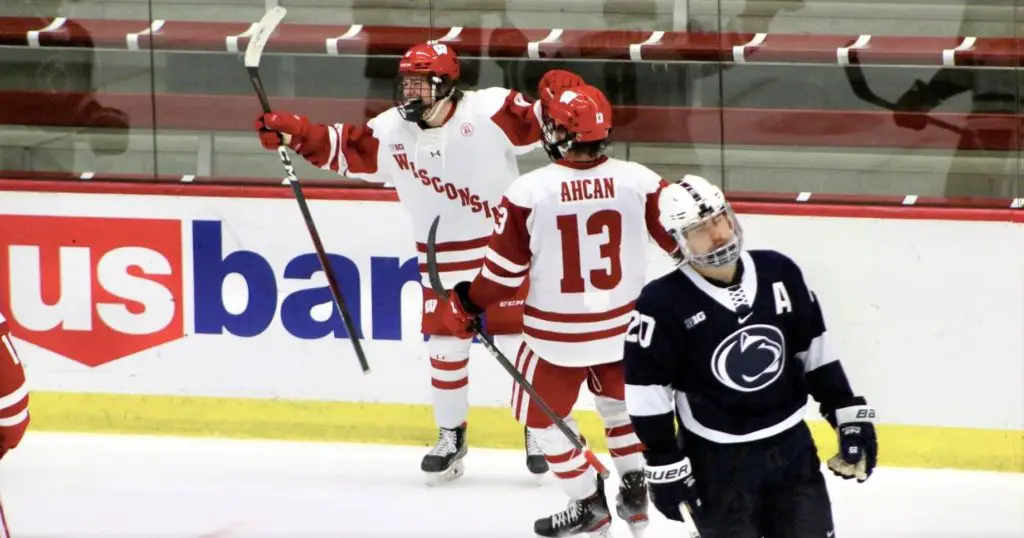Each week during the season, we look at the big events and big games around Division I men’s college hockey in Tuesday Morning Quarterback.
Jim: Paula, first off, it’s been too long since we’ve been able to sit down at our keyboard about 700 miles apart from one another and talk about college hockey.
For me, at least, March 17, our last Tuesday Morning Quarterback feature, seems like it was written 10 years ago. So let me bid you a fond welcome back and I sincerely hope you and all your family are safe and healthy at this very strange time in the world.
The somewhat good news is that 251 days later, there are some college hockey games played. I emphasize the word some, as to this point, there have been about as many games postponed, rescheduled or changed as there have been games played.
Since the Big Ten returned to play on Friday, November 13, a total of 21 Division I men’s games have been played, while 12 have been postponed. The reasons for postponement run from government regulations restricting teams from travel to a given campus to positive COVID tests among players and staffs.
Colorado College, Quinnipiac and New Hampshire all currently have positive cases among their team. Nine programs have entirely shutdown their programs for the season.
Our colleague, Candace Horgan, opened her NCHC season preview that ran yesterday asking, “Are we really going to do this?,” referring to whether or not playing Division I men’s college hockey at this time is the right decision.
So I’ll pose that question to you. Is playing college hockey right now the right thing to do?
Paula: Candace asked the question that needed to be asked and I commend her for it.
My short answer is that, no, I don’t think that playing college hockey – or any other sport – is the right thing to be doing now.
It is, of course, far more complicated than my simple, “Nope.” I am not a public health expert. I have no expertise in medicine. Also, there are seriously mixed messages coming from various state governments and a unified, “Open everything up!” coming from our government at the federal level, leaving people feeling everything from confusion to disbelief to anger.
There are people who say that sports and entertainment are rewards for a society that is functioning well, and people in that camp who argue against college hockey claim that we’re not a society that is functioning well at the moment. While I agree with the latter part – we are fragmented, going through more than just this pandemic – I am not thinking about the argument that we shouldn’t be rewarded.
I’m thinking about the science. I’m thinking about the healthcare system strained beyond its limits. I’m thinking about how easy it has become to look at COVID victims as collateral damage for doing business in America.
All of that having been said, I am torn about hockey because I love it so. I relish this chance to participate in our hockey community. I admire the spirit of carrying on and attempting to attain some semblance of “normal” in a fragmented world.
I do think that the colleges that have cancelled their seasons have done the right thing. It pains me to say that.
And, yes, March feels like decades ago. Everything has changed.
Jim: I think I’m actually leaning the opposite way of you on this one.
Do we need college hockey. Likely no. Can it happen safely? My gut is yes.
College football, a sport that is much more complex to successfully make happen, has for the most part successfully been played among the Power 5 conferences, and some others. Hockey should be able to execute a season, but thus far we have seen so many hurdles. It is quite obvious to me thus far that teams that play in Power 5 conferences have a distinct advantage. Hence why we haven’t seen many problems in the Big Ten. But other conferences are facing larger hurdles.
For me, I’m highly impressed by the simple amount of effort that has been put forth by every conference and every institution. While sports is something that is often dealt with by athletic directors, commissioners and administrators have gone out of the way to talk about the involvement from the President and Trustee levels. That top-level decision making has been beneficial to helping teams get back on the ice.
On the other side, though, I feel for the programs that are not playing. Certainly the student-athletes and coaches are disappointed, but more so I feel like there is permanent damage being done to these programs. There have already been rumors of players transferring out of the Ivies, RPI, Union and Alaska Anchorage. And the NCAA’s transfer portal is also filled with players from these schools wanting to transfer. These typically aren’t fourth-line players, rather some of the top talent at these schools up and down the lineup.
Whether or not this season is completed and champions are crowned, it seems that there could be permanent damage done for programs that have decided not to play.
Paula: There is no question, Jimmy, that there may be enormous implications for programs that are not playing.
Losing that top talent is one of the ways that all of those teams will be affected. Another is how programs will be affected sort of systemically as they sit out and other teams in their conferences continue to play. That experience, that growth that can happen over the course of the season, and the ways in which the teams learn from each other while competing – all of that is lost for teams that are opting not to play.
I’m glad that you brought up the ways in which decisions are being made that include entire campuses. Playing devil’s advocate against my own argument, institutions of higher education are suffering in the same ways that businesses are suffering: financially. Higher ed as an industry has taken a huge hit because of the pandemic, and high-profile sports can help generate much-needed revenue and heighten the profile of schools during a really difficult time. I get why collegiate sports continues.
In my mind, the reason doesn’t justify playing the games. Again, it pains me to say that. All it will take for my heart to break in a million pieces is for someone associated with NCAA hockey to sicken and die, or for someone related to a player who tests COVID positive to sicken and die and for that player to have to live with that forever.
I hear everything that you’re saying on safety, too. Look at the NCHC and its bubble. What an amazing concept. What an interesting experiment.
To paraphrase Bobby Motzko, the programs – and conferences – that can deal with the pandemic the best will come out on top in the end, whatever shape or form that end takes, and whenever it happens.
Jim: Let’s look a little bit at what has taken place on the ice to date. The Big Ten has played the most games, and two teams that most thought could excel are Michigan and Minnesota.
Each team has succeeded differently.
Minnesota is riding the success of its veterans while Michigan, which obviously getting strong play from an upper-class goaltender Strauss Mann, has four freshman leading the team in scoring. Mel Pearson knew he returned a solid nucleus but when you get contributions from your freshman class, that seems like a major bonus.
How do you handicap the Big Ten based on what we have seen thus far?
Paula: Having so much B1G hockey right away – in fact, it’s the middle of the second period between Penn State and Wisconsin as I write Monday evening – is a gift I hadn’t anticipated to start the season, and from what I’ve seen, Minnesota and Michigan are the two teams to watch as the season progresses.
The preseason coaches’ poll has Minnesota finishing first based on the Gophers’ remarkable second-half performance last year and my B1G writing partner, Drew Claussen, agrees with that assessment. I was inclined to as well until I saw Michigan play its first game. I cannot believe how much talent the Wolverines have this season, and Mann has returned to form.
Through four games, the Wolverines have scored 18 goals and allowed four. In their first two games, the Golden Gophers scored seven and allowed three. Michigan’s defense was solid last season while Minnesota’s was average, and both teams had middling offenses. The missing ingredient for the Wolverines last season was offense; for the Gophers, it was balance. Both teams seem to have improved where they needed to. I think everyone will be chasing Michigan and Minnesota.
It’s always interesting to see how talented rookie classes play out. Last year, a big influx of highly talented freshman made Wisconsin fun to watch but didn’t translate into the kind of season the Badgers wanted. This year, team chemistry is complicated for everyone because of the restrictions on how teams can interact because of the pandemic.
I guess we’ll see how it all plays out more quickly for B1G Hockey, with 40 total games scheduled to be completed by Dec. 20, including games against Arizona State.
And we’ll see soon enough how it plays out for all of college hockey. For what it’s worth, Jimmy, I hope you are right about everything COVID-related and that my skepticism is unfounded.
It’s good to hockey with you again, my friend. I hope that you and yours are safe as well.



